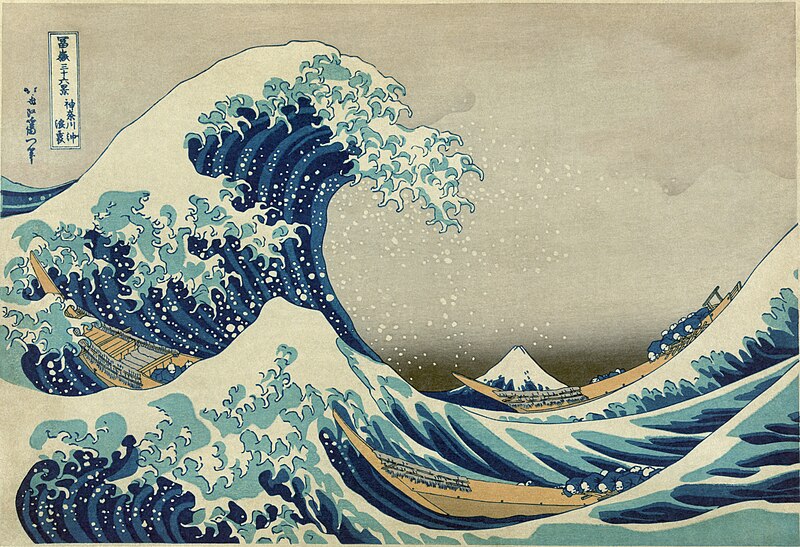Saturday, February 4, 2012
Winter tanka! (pt 2)
冬山に 来つつ しづけき心なり。 われひとり 出でて 踏む 道の霜
釈迢空 ORIKUCHI shinobu, a.k.a. shaku-chou-kuu (1887–1953)
fuyuyama ni kitatsutsu
shizukeki kokoro nari.
ware hitori idete
fumu
michi no shimo
arriving at the wintry mountain brings peace to my heart; I've come alone, and I step—into the road's frost
(The spacing isn't usual but reflects the formatting on the page, which must be mirroring how someone wrote it at some point. In fact, the last line is on the next page.)
松毬もおつるかぎり落ちはててこの冬の日に音一つなき
吉植庄亮 YOSHIUE shouryou (1884–1958)
matsukasa mo
otsuru kagiri (ni?)
ochihatete
kono fuyu no hi ni
oto hitotsu naki
the pinecone, too, reaches its time and drops from the tree; on this winter day, sound of a single cry
The award for weird kanji of the day goes to 毬. I don't think I'd ever seen けへん (?) before. I'm guessing おつる is related to おちる/おとす, to fall (or drop). The second line is all in kana, but the meter seems off; is it possible there should be a に ("限りに", at the limit)? はてる is interesting; there's a real sense of "at the absolute end". (Cf. Miyuki Nakajima: "涙もかれ果てて", having completely run out of tears. I've nosed around for more examples of "ochihateru", but aside from an adult comic I'm not finding much.)
夕寒く土間の鷄らのかえりつつ竈の榾火は燃えとろみ居り
吉植庄亮 YOSHIUE shouryou (1884–1958)
yoru samuku
doma no torira no
kaeritsutsu
kudo no hodabi wa
moetoromi ori/iri
in the night's cold—as the chickens come home to the dirt-floored house—the kindling burns down in the hearth
I'm guessing ら is pluralizing 鶏. "Doma" is a little strange, but per image search it seems to mean not just the floor, but a dirt-floored building, so maybe we're talking about chickens that belong to that house—土間の鶏の帰り. Or maybe not! Not sure what to do with 燃えとろみ; it seems to be nominal and be about burning (燃える), but the second half—a combination with とる, maybe?
炬燵して寒きをいとへ窓の下の蓮田の枯葉けふもしぐるる
中村憲吉 NAKAMURA kenkichi (1889–1934)
kotatsu shite
samuki o itoe
mado no (shita?) no
hasuda(?) no kareha
kyou mo shigururu
staving off the cold with the brazier; withered leaves in the hibiscus (or lotus) patch under (outside) the window. today, again, winter rain
(I'm taking いとえ as a form of 厭う/厭える, which may be off the wall but makes sense with炬燵 and 寒き. Not sure about まどのしたの because it's off meter. I'm just guessing at はすだ, but I feel OK about it because there's a city by that name in Saitama—so, at least the word exists with those kanji. して here seems to have the sense of で/を使って, rather than する, per Shirane §12.9.)
2011 earthquake data, condensed.
I can't embed it because Google is having an identity crisis, so here it is.
Assuming this is based on valid data, etc., I concur with a YouTube commentator: Dam nature, you scary.
Friday, February 3, 2012
Hokusai prints lost at sea?!
Seems there was, aboard the recently-capsized Costa Concordia, a collection of woodblock prints by KATSUSHIKA Hokusai (葛飾北斎). 残念ですね!Apparently they were in a spa that seems to have been on the Spagna deck, third deck down, fore, probably on the port side; not sure whether that part of the ship is actually underwater, but since the ship is submerged on the starboard side, maybe there's hope.
Hokusai (1760–1849) was from Edo and, although he's probably best known for his 36 Views of Mount Fuji (of which in fact there are 46, plus another set of 100), his Great Wave of Kanagawa has in the Occident become iconic and emblematic of woodblock as an art form:
Hokusai (1760–1849) was from Edo and, although he's probably best known for his 36 Views of Mount Fuji (of which in fact there are 46, plus another set of 100), his Great Wave of Kanagawa has in the Occident become iconic and emblematic of woodblock as an art form:
Subscribe to:
Posts (Atom)

